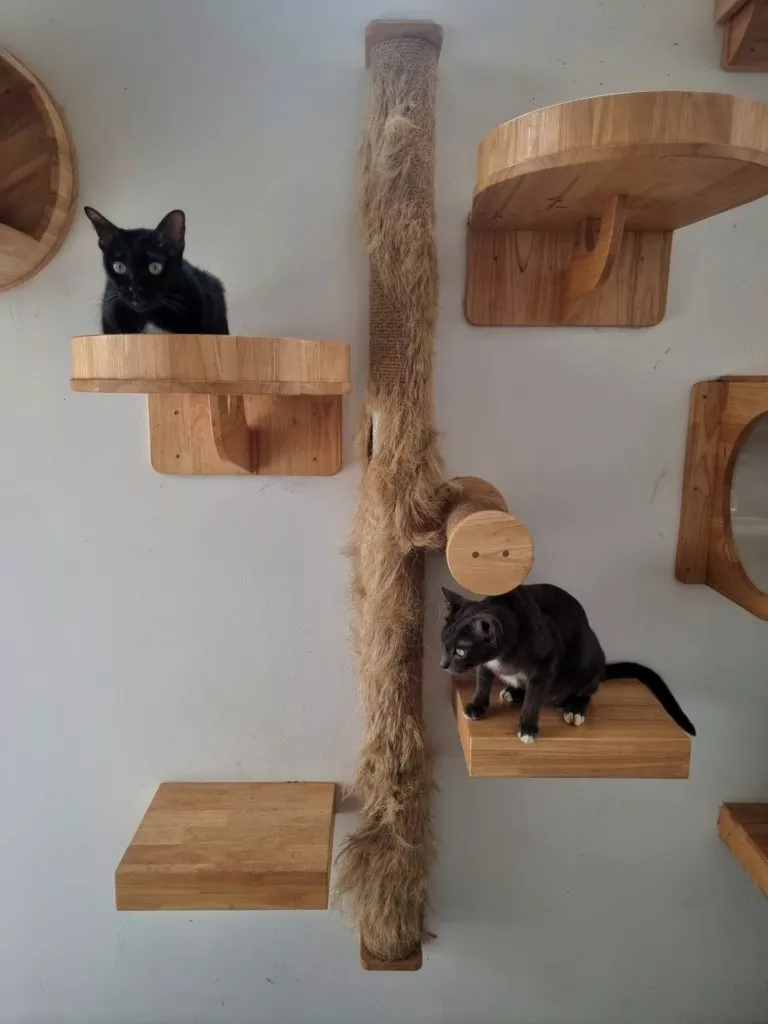Cats are known for their instinct to climb and explore, but with most Aussie felines now living an exclusively indoor lifestyle, opportunities to engage in these activities have proven limited without upsetting those pesky housemates – aka the humans.
So, if a scratch tower isn’t satisfying your cat’s exploration itch anymore, why not reward your curious feline with a creative shelf arrangement?
In this simple guide, we’ll give you our best tips on how to design your very own pet playground using easy-install shelves to create a catwalk adventure that will keep your furry friend entertained.
Location:
The first step is to choose the “purr-fect” wall for your cat wall installation, as this can’t be easily changed later.
Most house cats like to be in close proximity to people, so a catwalk is best suited to be in the living area where they can observe the household action while enjoying the elevation of their new sanctuary.
If your cat is less social, you can install the catwalk in their favourite room.
Ensure your chosen location has enough room to build an unobstructed pathway with limited dead ends to encourage use.

Measurements:
Measure the wall to determine spacing and the number of shelves needed, then measure your pet to ensure the shelves are of suitable length.
Build-it recommends a staggered layout across the room’s wall that will allow your kitty to move gracefully from ledge to ledge, mimicking the experience of climbing a tree, fence or roofing.
A rough guide for a healthy medium size cat should be shelves spaced 30-45cm apart with a horizontal spacing of 30-40cm. However, you may want to consider your cat’s age and abilities before deciding this.
Weight and materials:
Before installing the catwalk, you must ensure the floating shelves you select can withstand your cat’s weight. You can find the maximum load of your desired shelving in-store or online before purchasing.
Most cat owners opt for shelves made from a wooden material, with both bracket and floating shelving popular choices.
Other materials, such as plastic, are also options but can restrict adjustments and attachments if required.
If you choose raw timber materials, it is essential to apply a non-toxic finish and allow it to cure before installation to safeguard the health of your feline friend.
Securing:
Most walls are made of plasterboard, so use a stud finder to help locate the framework’s studs and noggins and avoid drilling into wall areas that contain wiring or pipework.
Once the studs are located, use painter’s tape to mark the location of the shelving brackets, ensuring they are centred over the wall’s studs. Keep the fixings on the tape and check both are level.
Fix the brackets to the wall and attach the shelf panels using screws.

Design and Personalisation:
Many cats will be reluctant to traverse a new area without purpose. Designing your catwalk with a finish line incentive is essential to encourage their usage – a feeder, treats or attractive resting spot can assist this.
To make your cat’s climbing wall even more enticing, add some scratching mats secured using double-sided adhesive tape.
Hanging dangling toys from the edge of a few platforms can also add to the excitement and encourage activity and movement.
Scratching posts can also be installed as part of the catwalk by screwing them vertically between rows of shelving to hold them in place, while cut-outs in the shelving to house food bowls may be a great incentive to encourage usage for timid cats.
Creating additional pathways between a few shelves may also be required as some cats find it difficult to access the highest platform due to the ceiling impacting their jump space – solve this by adding a ramp, bridge, or entry hole through the shelf.







